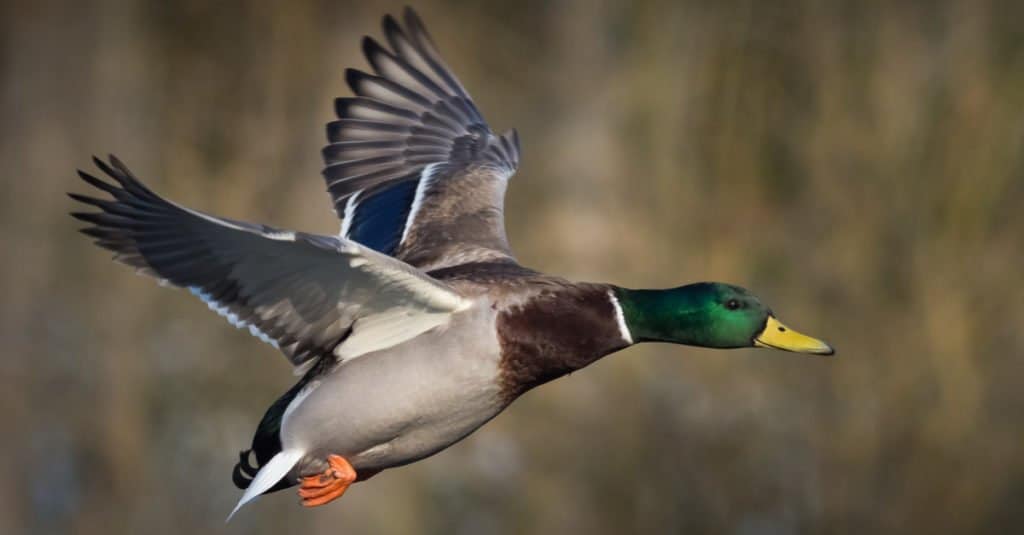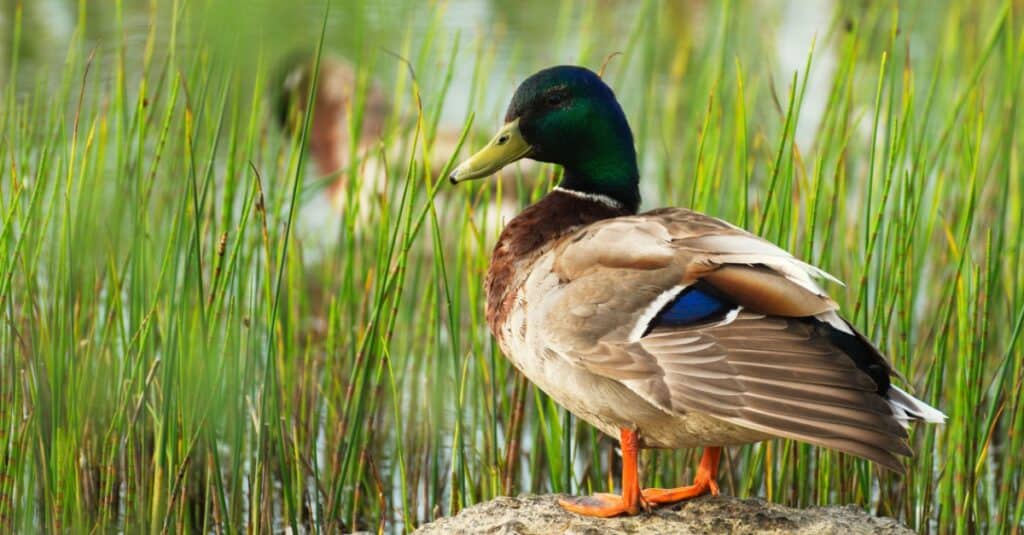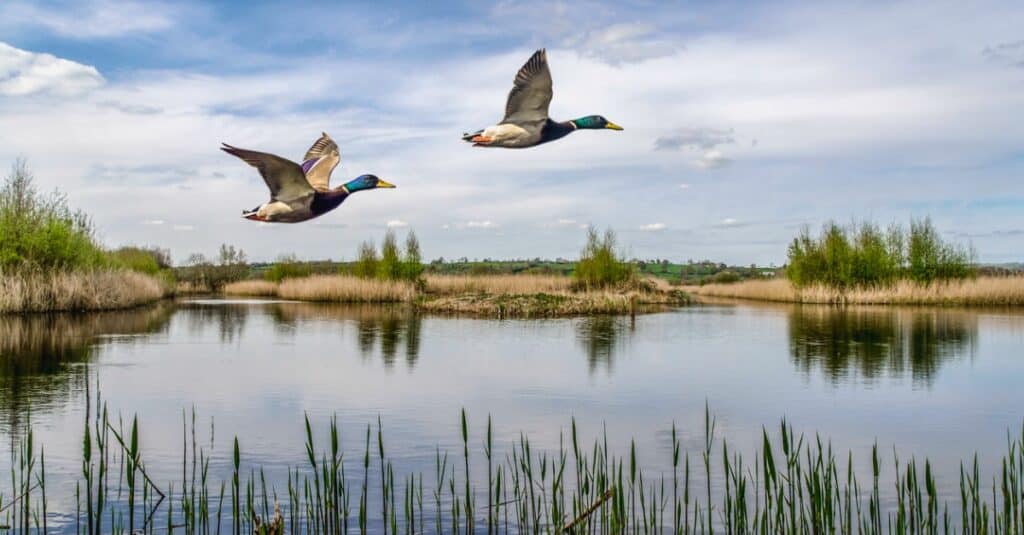After domestic chickens and turkeys, ducks come next in terms of domestic popularity. A mere mention is sufficient to conjure images of a waddling avian with a green head, brown chest and grey wings, or plainer mottled brown plumage — with the latter followed by tiny black and yellow ducklings. And unlike the goose, they are not known for a penchant for violence.
Hence, it is only natural that we feel rather curious about these rather placid avians. How long do ducks live?

Depending on the breed, ducks can live anywhere from five to 10 years on average, but they can live up to 20 years if properly cared for.
In part, the lifespan of a duck is determined by its genetics. However, there are many human-controlled elements that can influence the outcome of their longevity. Nutrition, housing, health and well-being, and environment are all factors in this.
How Long Do Ducks Live?
The mallard, the most common duck in the United States, will be the focus of this article. The mallard can be found on almost every flight path. They are in abundance in the lower Mississippi basin and the Gulf Coast, however many linger as far north as the open water allows them.
Mallard ducks in the wild have a lifespan of between five to 10 years. They can live as old as Pekins and Calls if properly cared for in a good homestead environment.
Lifespan: Domestic Duck
The average life span of a domestic duck is 10 years or less. As a rule, the larger breeds of duck have the shortest life spans. Mallard ducks are domesticated in the same way as most agricultural animals. It is typically raised for meat and/or eggs. This results in a larger, heavier duck with a higher egg-laying rate than wild breeds. Because farmed ducks can’t fly, their wings are often shorter than wild ducks’.
The mallard is a popular farmed duck breed. It is believed that this duck was domesticated in South Asia from a wild mallard strain. They are still allowed into rice paddy areas to consume insects that harm crops.
Lifespan: Wild Mallards

Wild mallards are smaller and leaner than domesticated mallards and can live longer.
©Rostislav Stach/Shutterstock.com
A wild mallard’s lifespan ranges from five to 10 years. Wild mallards are smaller and leaner than domesticated mallards and can live longer; that is if predators don’t get to them first. In the first year of life, more than half of mallard ducks will be eaten by predators such as the American crow and mink, as well as the fox, coyote, raccoon, squirrel, and snapping turtle.
Lifespan: Pet Ducks
Pet ducks can live past the age of 20 in exceptional cases when well cared for!
Domesticated ducks are widely bred as pets, especially as ducklings for seasonal festivities and holidays. Typically, these ducks are not properly cared for and either die of accidental neglect or are killed or rejected as adults.
Domesticated ducks released into the wild face several major difficulties, including malnutrition and famine, but also improper food from park-goers like bread and crackers can teach them incorrect foraging skills and quickly worsen their health. Ducks need plants and protein, not sugary simple carbs.
A well-cared-for pet duck can live for 10 years or more. Several accounts exist of pet ducks living into their twenties. Among the stories are Ernie, 21, and Edwina, 22, both from the U.K. A Mallard drake (male duck) presently holds the world record for the oldest duck at 26 years 4 months!
Factors That Affect Duck Longevity
With the burning question “how long do ducks live?” out of the way, it’s time to focus on factors play a key role in prolonging their lifespan. Whether you keep ducks as pets or let them go free in your farm fields. ducks have needs beyond basic food, water, and shelter. If you are a duck owner, there are many ways to maintain their general health.

Ducks have needs beyond basic food, water, and shelter to keep in optimal health.
©iStock.com/M-Production
The health of a domestic or pet duck is determined by:
Healthy Food and Clean Water
Ducks need plenty of greens. If you let ducks roam free around your backyard or comparable area, they will eliminate weeds and keep the grass trimmed. That keeps their energy and nutrient levels up. If you have clean vegetable peelings, this can give them a boost. Grit also helps ducks digest the food they’ve eaten elsewhere, which helps them live longer.
Finally, provide plenty of clean water for your ducks. Anyone who owns ducks knows they love to swim and play in the water, thus putting out only a bowl full at a time will result in frequent refilling. Give your ducks fresh water at least twice a day, in a container deep enough for their heads to submerge.
Proper Shelter
Making sure ducks have a comfortable place to sleep and shelter is as vital as providing them with food. While ducks are very low-maintenance compared to other birds, you may need to provide some housing for your flock depending on your location/weather.
Ducks don’t require much. Their home might be a 3-foot high wooden box or an old doghouse with four square feet of floor area for each duck. A warm nook of the house with a straw pile is ideal for a nest.
Ample Space
Allowing your ducks to range freely will keep them busy all day. If you keep ducks in a coop or tractor, relocate it often. This gives them access to fresh grass and a change of scenery, which is good for their health.
Vet Care
Well-being includes veterinary care. Regular flock checks and early medical attention are ways to ensure your duck enjoys a long life. You can also buy natural supplements to add to meals and drink to help prevent sickness and illness.
Keep It Domesticated

Releasing mallard ducks into the wild that have been raised by humans is a death sentence, as they are unable to fend for themselves.
©iStock.com/Nathanx1
Wild mallards are outstanding flyers. Migrating mallards can fly 800 miles in eight hours with a 50 mph tailwind. Because many duck species migrate large distances in the winter, their wings are short, powerful, and pointed.
Releasing mallard ducks into the wild that have been raised by humans is a death sentence, as they are unable to fend for themselves. Those without wild impulses will be unable to migrate or can become too fat to fly. It’s also against the law to own and release domestic ducks on public grounds.
All the above-mentioned care tips are necessary to ensure your duck lives a long life. If you aren’t thoughtful, you risk losing your duck before it has a chance to fully mature.
The photo featured at the top of this post is © Pascal Halder/Shutterstock.com
Thank you for reading! Have some feedback for us? Contact the AZ Animals editorial team.






